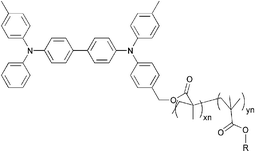Abstract
A bis(diarylamino)biphenyl-functionalised methacrylate has been synthesised and polymerised to give a hole-transport

* Corresponding authors
a Department of Chemistry, The University of Arizona, Tucson, USA
b Optical Sciences Center, The University of Arizona, Tucson, USA
A bis(diarylamino)biphenyl-functionalised methacrylate has been synthesised and polymerised to give a hole-transport

 Please wait while we load your content...
Something went wrong. Try again?
Please wait while we load your content...
Something went wrong. Try again?
Y. Zhang, R. D. Hreha, G. E. Jabbour, B. Kippelen, N. Peyghambarian and S. R. Marder, J. Mater. Chem., 2002, 12, 1703 DOI: 10.1039/B110088M
To request permission to reproduce material from this article, please go to the Copyright Clearance Center request page.
If you are an author contributing to an RSC publication, you do not need to request permission provided correct acknowledgement is given.
If you are the author of this article, you do not need to request permission to reproduce figures and diagrams provided correct acknowledgement is given. If you want to reproduce the whole article in a third-party publication (excluding your thesis/dissertation for which permission is not required) please go to the Copyright Clearance Center request page.
Read more about how to correctly acknowledge RSC content.
 Fetching data from CrossRef.
Fetching data from CrossRef.
This may take some time to load.
Loading related content
